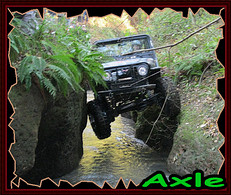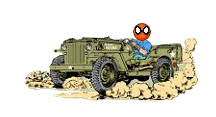If you haven’t already figured it out I have this fixation about cooling and under hood temperature management. Fortunately for me my friend Kevin owns an automotive test lab and is kind enough to let me use some of his specialty equipment to do these kinds of things.
Thanks Kevin!
If you have an interest, here are some related threads on this forum dealing with Temperature Management.
Auxiliary Cooling – Hood Louvers / Vents.
http://jeepsunlimited.com/forums/showthrea...ghlight=cooling
Coolant Temp Testing: Fan/Clutch vs. Flex-A-Lite 475 Electric Fan.
http://jeepsunlimited.com/forums/showthrea...9&highlight=Fan
Managing York OBA Temperatures.
http://home.att.net/~email.id/wsb/html/vie...home.html-.html
This one, while not temperature related does have a little bit of info on oil filter effectiveness. You might find it interesting.
Oil Filtering Effectiveness - Fram/Napa/Pure1/Mobil1/OilGuard.
http://jeepsunlimited.com/forums/showthrea...20&pagenumber=1
What is an Oil to Coolant Cooler?
Glade you asked!
Here's a picture from the front side.

And here’s another from the backside.

How Does it Work?
This oil cooler, like all others is a heat exchanged.
This design incorporates a honeycomb oil passageway inside which is surrounded by a chamber in which engine coolant is pumped through.
The Oil to Coolant Cooler is sandwiched between the engine bock and the engine oil filter.
Unlike conventional oil coolers, hot oil in this design never really leaves the engine to any great extent while being cooled.
Visualize this while looking at the two pictures I posted above. The “Cooler” bolts to the engine block where the oil filter would normally go. The oil filter then spins onto the “cooler”.
When the engine oil pump pushed hot oil out to be filter it first has to go through this unit to be cooled a few degrees before reaching the filter.
After being filtered, the clean oil has to travel back through this cooler, where more heat is removed, prior to the clean oil entering the engine.
Here is a picture of what this unit looks like with an oil filter attached.

Take a look at the two hose nipples.
This cooler has two hose connections on it that attach, inline with the heater core return hose.
The engine water pump continuously pushes a flow of coolant from the engine to the heater core and back to the engine. This happens on the TJ 4.0L engine (and most others) independent of the heater selector controls in the cab.
The Oil to Coolant Cooler taps into the heater core return line. Basically you cut the line and attach one end to one hose nipple on the cooler, and the other end of the heater core return hoes to the second nipple on the cooler.
Once your engine is warmed up to operating temperatures, the Coolant Temperatures” are significantly LOWER then your engines “Oil Temperatures”. It is this temperature differential that enables the “Cooling of the Oil” and creates a closer equilibrium with your engine between the oil (which is also cooling the engine) and the coolant.
How Well Does it Work?
I did quite a bit of testing on this during the dog days of the summer. I will share with you how I did this and the results of my testing. I have my own conclusions based on this testing effort.
You are welcome to form your own, but I will tell you right now, I was able to lower the average temperature of my engine oil by a little more then 14 degrees F.
Testing Methodology
Here’s how I did the testing.
Prior to testing the Oil to Coolant Cooler I wanted to have some type of baseline to compare test results to. In order to create this baseline I needed to test both Engine Coolant and Engine Oil Temperatures without the cooler installed.
I installed two of Kevin’s remote temperature sensors. One at the Engine coolant system gooseneck, and the other at the oil pressure-sending unit.
These sensors where connected to the ‘black box” computer system that poled each sensor three (3) times per second and recorded the temperatures into a database. Being these temperatures where recorded at exactly time intervals, the data collected was recorded over time. This enable the ability to see the “ramp up” or how fast or slow the coolant or oil reached operating temperatures.
Please note the entire test consisted of starting a stone cold engine and driving it from my home to the interstate highway, where I then continued to drive for 1 hour. The Black Box was set to begin to collect data once the temperatures reached just above 100 degrees F.
Engine RPM was kept at 2,200 as much as I possibly could.
Outside air temperature at the start of this test was 95.6 degrees F.
Baseline Testing
Here is a graph representing ALL the temperatures collected during a 30-minute period of time, (5,400 temperatures over 30 minutes for each.) prior to installing the cooler.

The Red Line represents the temperatures, over time, of the Engine Coolant.
The Blue Line represents the temperatures, over time, of the Engine Oil.
What I find remarkable about this chart is that the engine Coolant ramps up to operating temperature much quicker then the engine oil does.
What does this mean to me, or how important is it?
I have no clue, but it is fairly obvious and therefore notable to me.
Highest Temps
The highest temperature recorded in the first 30 minutes for each, prior to installing the cooler are:
Oil = 268.8 F
Coolant = 202.9 F
After the first 30 minutes both the coolant and engine oil temperatures became very stable.
If I were to include them in this graph the variances would be so small you could not see them. (Read that; for the most part they would be a straight horizontal line.)
The Second 30 minutes of this test resulted in the following;
Oil Average Temperature = 250.4 F
Oil Highest Temperature = 273.2 F
Coolant Average Temperature = 204.7 F
Coolant Highest Temperature = 209.5 F
Oil Cooler Results
Here is a graph of the first 30-minutes using them same testing procedures as those used to create the baseline. (As close as I could make them the same.
Outside air temperatures at the start of this test were 97.4 F.

Looks a little different don’t it?
Don’t worry I’m going to put the two graphs together so you can see the changes more clearly.
Seem to me like the oil temps are a lot more linear then they were before. Could the “Coolant Temps that raise quicker be transferring heat to the cooler oil for the first 25 minutes or so? Helping the oil get up to operating temperature quicker?
Here are the numbers after the Oil to Coolant Cooler was installed.
Highest Temps
The highest temperature recorded in the first 30 minutes for each, prior to installing the cooler are:
Oil = 237.6 F[u/] (This is 31.2 F cooler then the baseline)
Coolant = 202.0 F (This is 0.9 F cooler then the baseline?)
Once again after the first 30 minutes both the coolant and engine oil temperatures became very stable.
The Second 30 minutes of this test resulted in the following;
Oil Average Temperature = 236.1 F (This is 14.3 F Cooler then the baseline)
Oil Highest Temperature = 242.1 F (This is 31.1 F Cooler then the baseline)
Coolant Average Temperature = 207.4 F ( 2.7 F Warmer then the baseline)
[u]Coolant Highest Temperature = 209.8 F ( only 0.3 F Warmer then the baseline)
My Interpretation
My testing shows that he Oil to Coolant Cooler does a nice job of lowering the engine oil temperatures what looks like a bit more then 14 degrees F. at 236.1 degrees F it falls within the SAE idle oil temperature range of 210 to 240 degrees F.
Anything lower then 210 F will not allow water to be boiled off out of the oil.
Anything over 240 degrees cause the oil to allow higher level of wear.
The “cost” of doing this appears to be an additional 2.7 degrees F to the coolant temperatures. Give that’s within what I consider to be normal operating range I am comfortable with that.
Direct Comparison Graphs
For your reading pleasure.
Oil Graph

Coolant Graph[/

Additional Captured Info
I left the Temperature sensors installed on my Jeep for better then 6 weeks.
During this time the oil temperature never exceeded 244.2 degrees F.
The total average temperature of the oil during this time was 232.7 degrees F.
While I have the data for coolant temperatures during this period I have not analyzed it for highest or average. I will at some time. Right now all I can say is there were no problems that I am aware of with the coolant temperatures going outside a normal operating range. (I’ll get to this data shortly.)
Installation Pictures
This unit is installed on my 1997 Jeep TJ 4.0L. Testing was
The installation is straightforward. If you know how to remove and install your oil filter, you have just about all the skills you need.
Find your oil filter and remove it.
Note: Put a pan under it or you get a mess. Don’t laugh. For whatever reason when I installed this unit on my Jeep I didn’t put the pan under there before taking the filter off. (OK, ok, you can laugh, I deserve it!)

Here’s a look from the bottom after you remove the oil filter.
The threads that the oil filter screws onto are the same threads the oil to Coolant Cooler will screw onto.

Position the Oil to Coolant Cooler in place on the threads and slowly thread it into place. Once the gasket contacts the engine plate, position the Cooler where you want the hose nipples to point and then tighten down on the nut on the outside of the Cooler. This will compress the seal against the engine and set your hose position for you.
Here is what it looks like from the bottom.

And here is what it looks like from the topside of the engine compartment.

Then simply install the engine oil filter onto the cooler. Hand tight with another ¼ turn.

All that is left to do is cut the heater return hose (11/16-inch) and attach each end to the top cooler nipples and refill your coolant and top off the engine oil level.
Sorry I ran out of digital memory camera card and don’t have pictures with the two hoses attached. I will get some though, even if basically boring!
Where to find an Oil to Coolant Cooler
FORD
These things are not common, but they aren’t rare if you know where to look for them.
In addition they come in different flavors and styles too.
The unit I installed came off of a 1989 Ford Crown Victoria Police Cruiser. In the 1980’s and early 1990’s these units where an option when the police cruisers where ordered by the factory.
The unit is made my Modine Manufacturing.
PLEASE NOTE: If you go salvage yard hunting you need to know these come in two thread sizes. You want a unit off the following Ford Engines. Small block 289, 302, 351C or 351W. Also off the old big blocks, 352, 390, 427 (yes Ford made one, it was a SOHC engine) or the 428 wedge.
On rare occasion you will find one of these on a 190 – 92 Ford Mustang.
And believe it or not, almost all the 4 cylinder Merkur (spelling?) have this unit installed.
The oil filter threads on all above engines are a perfect match to those on the Jeep 4.0 and 2.5L engines. (I will give exact thread size later. I don't have it in front of me right now.
[b]DO NOT get one off the new “Modular (read that metric, 4.6, 5.0 etc.) V8’s. They use the 22 mm filter thread and that will not fit the Jeep engine.
I have more info on other, different flavors of these oil to coolant coolers that I will post hopefully tomorrow. Along with similar coolers to handle the Power Steering Fluid temps too.
That’s it for tonight folks.
I will post this, see all my typo’s after I post it and spend half the night fixing them.
I hope some find this useful.
Frank

 Help
Help


















